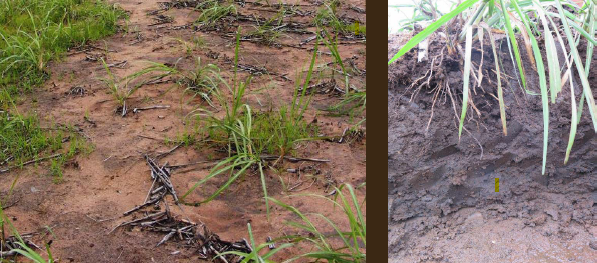Improving your fertiliser use
Fertiliser prices have reached record highs. Under these conditions, it is important to adopt practices that improve the effectiveness of your fertiliser investment.
Sampling and testing
Soil and leaf testing will help you gauge which nutrients are in excess, adequate or in short supply, as well as highlighting potentially crop-limiting conditions. Soil and leaf testing are essential in determining the nutrient requirements for your crop and for evaluating the success of your nutrition programme. Ensure proper sampling protocols are followed to ensure sample representation.
Soil health
Remove or manage crop limiting conditions such as acidity, compaction, waterlogging and salinity and sodicity as these reduce the efficiency of fertiliser use.

Constraints such as acidity (left) or waterlogging (right) will greatly reduce the ability of the crop to utilise applied nutrients.
Realistic target yields
Providing realistic target yield estimates will improve the fertiliser recommendation you receive from Fertiliser Advisory Service (FAS).
Using the 4R’s to better use nutrients
The 4R’s refer to the Right source (type), rate, placement and timing of application of fertilisers.
By considering all these factors to optimise nutrient use by the crop, it may be possible to refine your fertiliser rates and find savings through efficient use.
Right Source: Select fertilisers that reduce the risk of losses in a given situation, and that will supply the crop with the required nutrients.
Right Rate: Under-and overapplication of nutrients can lead to yield loss, unnecessary costs and environmental pollution.
Right Placement: This can affect how easily the crop can access and use the applied nutrients, as well as the risk of losses.
Right Timing: Coinciding nutrient application with periods of crop need improves uptake by the crop while reducing losses.
When could you consider adjusting or reducing fertiliser rates?
- If you routinely apply excessively high rates “just-in-case” or if soil tests indicate adequate phosphorus (P) and Potassium (K), you are very unlikely to get a crop response to the extra application.
- If you routinely apply a blend containing nutrients not required in that crop cycle – switch to an alternative source that better matches requirements.
- If the previous seasons leaf testing indicates excessive uptake of a nutrient, consider cutting back on the following seasons application rate.
- If the previous seasons crop underperformed, you may have residual nutrients left in the soil and reductions are often possible (mainly P and K).
- After accounting for all nutrient inputs (e.g. filtercake, manures) and by adjusting your conventional fertiliser application rates accordingly.
- In acidic soils that are limed, you can reduce Nitrogen (N) application in the year or two after liming due to improved N mineralisation.
- In high organic matter soils (>2% OM), consider reducing N rates on replant cycles.
- Cut N rates in plant crops which were preceded by legume crops.
- Try maintaining a balance in nutrient supply (even if applied at lower rates) rather than dropping one nutrient in favour of another.
- In the short term (one or two seasons), consider reducing or cutting P application in ratoon crops where soil tests indicate sufficient P levels or large amounts of P were applied in the preceding seasons.
- Your target yield given during sample submission was higher than is likely for the coming season.
Use monitor farms for evaluation
Monitor plots can be a useful tool to evaluate adjustments to your nutrition programme, in particular N. In the picture below, by applying a high rate to test plots on the left, it became apparent within a short period of time that the crop would respond to extra N. If no or small differences appear, it indicates that additional N is not likely to improve yields. Where these tests are done before the cane reaches the “out-of-hand” stage, it increases the opportunity to more easily apply an additional amount of fertiliser if required.


